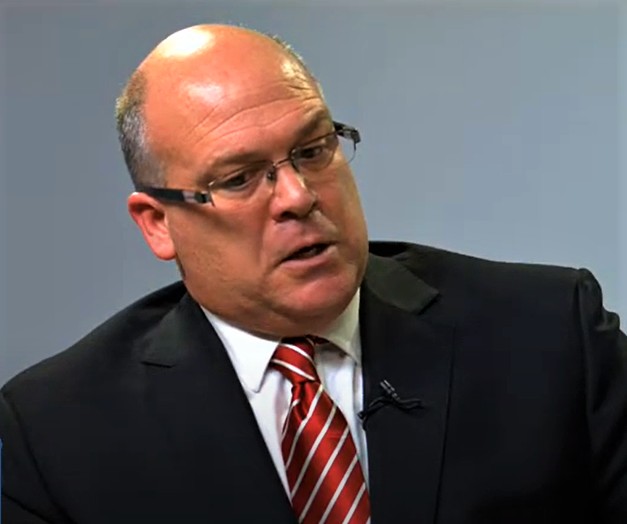
After forsaking the environment for the GTA West Highway are Caledon leaders coming around or playing games?
It’s getting crowded on the fence.
Some Caledon council members have climbed on top, joining colleagues in Brampton. In public statements issued last week, Councillor Jennifer Innis and Mayor Allan Thompson have attempted to rewrite their history of support for the GTA West Highway.
For years, councillors in Caledon have pushed planning for the route, also known as Highway 413. This support has ranged from enthusiastic endorsement of an environmental assessment (EA) needed for the project, to statements backing the highway itself. Thompson has been particularly forceful, and along with Innis and Councillor Johanna Downey they have consistently voted in support of efforts meant to clear the way for a new 400-series highway that would rip through Caldedon’s agricultural lands and encroach on the protected Greenbelt.
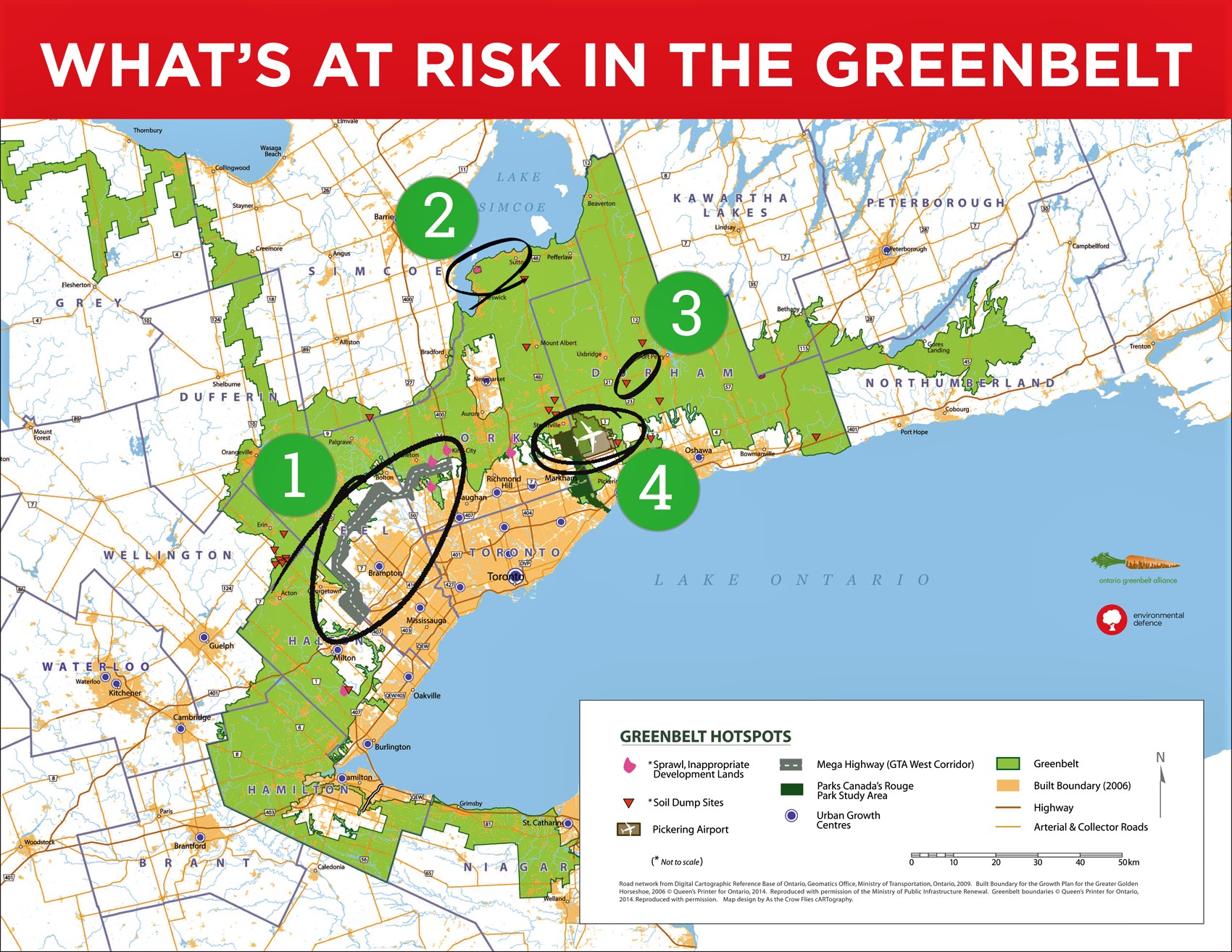
The GTA West Highway corridor is circled in the map above.
The project would be an environmental disaster, according to a number of groups now fighting to stop the Doug Ford PC government from pushing forward with the plan despite the conclusion of an expert panel in 2018 that recommended scrapping the idea.
That’s what the previous Liberal government did. But, with the support of Caledon’s leaders, and after making promises to developers, Ford put the project back on the table.
Now, as the public and environmental groups mount a fierce opposition to the highway, supported by a growing number of municipal councils, elected officials in Peel have found themselves under pressure to take a stand.
The highway is a contradiction of policies in all three of Peel’s municipalities and at the Region itself. From active transportation plans and environmental master plans to transit expansion, smart growth and climate emergency declarations, a massive 400-series highway corridor makes a mockery of these previously approved commitments.
In Mississauga, council members recently acknowledged this and on Wednesday endorsed a powerfully worded motion opposing the route’s construction.
It did not mince words: “WHEREAS the proposed Hwy 413 will slash a broad 59 km swath through agricultural, natural heritage and environmentally sensitive lands - bisecting 85 streams (10 of which are ecologically high priority) destroying seven entire wood lots including a 5.95 km length of forest, significantly fragmenting valley lands, disrupting 1,000 ha of land significant to wildlife movement - making serious incursions into areas protected under the Greenbelt Plan; WHEREAS the 413 project would create 8.8 million square metres of paved surface, right of way land and Transitway property (880 hectares/2174 acres), the equivalent of 13.59 functioning Ontario farms without consideration of the added Transitway Corridor; WHEREAS the 413 project will include a minimum of 60 metres for an adjoining transit way, in addition to 110 metres of vehicle lanes and another 60 metre right of way for a Transmission Corridor to support the sprawling employment buildings and residential subdivisions that will follow the highway; WHEREAS a significant number of reputable organizations have demanded the cancellation of the project, including: Environmental Defence, the David Suzuki Foundation, the Federation of Urban Neighbourhoods, Gravelwatch, Halton Environmental Network, National Farmers’ Union-Ontario, Rescue Lake Simcoe Coalition, Sustainable Vaughan, Transport Action Ontario, the Wilderness Committee and Sustainable Mississauga; as well as formal votes from the municipalities of Halton Hills and Orangeville; WHEREAS the TRCA - which is the regulatory authority for developments in flood plains, wetlands and valley lands - has also objected to the potential impact of the proposed highway as well as the streamlined Environmental Assessment process, as has the Region of Peel… Be it resolved that The Council of the City of Mississauga approve the following… Strong opposition in principle to construction of any transportation corridor transversing the Region of Peel, but specifically the currently proposed GTA West 413 highway.”
The approved motion, which was moved by Councillor Carolyn Parrish, called for it to be shared with Brampton, Caledon and Peel councils. But when it was brought forward at Peel Regional Council the next day for a vote some members from Caledon and Brampton stood on the fence.
For Thompson, Innis and Downey it’s a move toward the will of the public, away from their previous support for the highway, but they remain unwilling to go all the way.
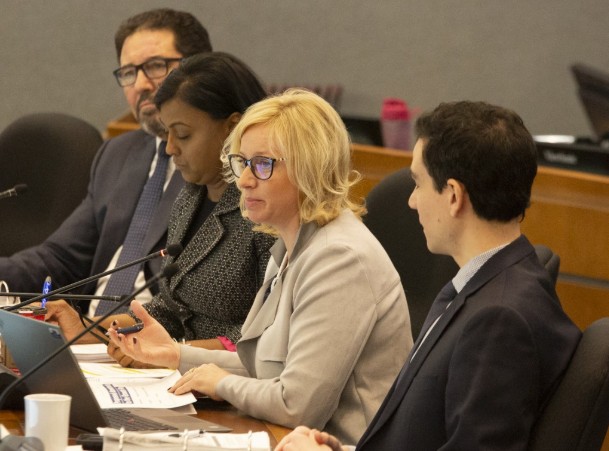
Caledon Councillor Jennifer Innis, centre, has lobbied for the GTA West Highway, but now says she has only supported an EA.
Along with Brampton Mayor Patrick Brown, who has aggressively pushed the highway and even pointed out he was the one who put it on the PC party platform during the 2018 election campaign, when he was the leader, some members of Peel Council have refused to take a firm stand against the construction of the 413 Highway. Twelve members managed to stop the vote Thursday, instead passing a motion to have staff study the implications.
Caledon’s position could determine the future of growth in the GTA’s largest remaining stretch of undeveloped land.
The municipality, geographically larger than the City of Toronto, will house hundreds of thousands of Ontarians over the next few decades. Growth targets set by the Province mean it will inevitably transition from a collection of rural townships, dotted with family farms and countryside houses, to a development hotspot.
To the south, Brampton and Mississauga offer cautionary tales of how to manage this transition from rural to urban. Both grew lazily, spreading out around highways with subdivisions gobbling up farmland and creating an environmental nightmare.
The costs of sprawl are still wreaking havoc on Mississauga and Brampton finances, as the price of spreading services out to far flung corners of each municipality, where people live in low density enclaves that require incredibly expensive infrastructure, eat up annual budgets.
Cities do very well when gathering large amounts of property tax revenue from a small footprint, while all the required infrastructure can be delivered to one spot. A 15-storey condo building with 100 units can provide $300,000 of annual property tax revenue, while expensive roads and utilities along with fire, paramedics, transit and policing can be delivered right to one block.
A subdivision model with single family homes requires far more infrastructure costs to reach each unit, while generating just a fraction of the property tax revenue.
Toronto home owners, thanks to a much more dense built form, pay far less in taxes compared to their Peel counterparts.
According to 2018 Toronto Real Estate Board data, Toronto East residents paid $4,905 in property taxes on an average house assessed at $772,000. Brampton residents paid $7,207 on an average house despite a lower assessed value of $696,000. In Mississauga the average amount was $5,980 for a home assessed at $726,000.
Both Peel cities are now faced with the difficult task of densifying previous sprawl, running transit to subdivisions and convincing local residents — who bought a slice of suburbia — they should accept condominium towers overlooking their backyards. It’s not easy.
Rather than following the same, destructive development pattern, Caledon is being encouraged to build density and complete communities from the beginning. Instead of swallowing up the white-belt (land sandwiched between Brampton and the Greenbelt) with sprawling single-family subdivisions, it could use a far smaller area for its urban footprint and bring density and transit to its growth strategy.
But the subdivision developers have already bought up most of the land along the GTA West Highway corridor and they stand to make a fortune, just as they have for decades with their sprawling approach that gets pushed on helpless municipalities represented by politicians funded by the same developers.
York University political science professor Robert MacDermid studied campaign contributions for the 2014 municipal election and found that in areas where growth and new developments were still happening at rapid rates, builders controlled the financing of candidates. More than 300 candidates who ran in 13 municipalities were studied across the GTA and areas such as Barrie.
Developers made up by far the largest share of private-sector funding, and even rules introduced since, prohibiting corporate, private-sector funding in municipal elections, are easily skirted by simply sending in donations through individuals.
The most alarming revelation from MacDermid’s work was the reporting that 60 percent of the corporate donations to candidates in 2014 came from outside the municipality where the individual was running.
These developers had little interest in issues impacting the communities, they simply wanted to influence elected officials on growth and planning matters that had a direct impact on their profits.
But now, Caldedon residents are voicing their frustration over the takeover of planning in their community by developers who use elected officials to do their bidding.
At the heart of the confrontation is the 413 Highway. If the GTA West Corridor is constructed, it will encourage developers to slap together traditional subdivisions where residents hop in their car and onto the highway, without a thought for public transit or the effects on climate change. Despite paying homage to the environment in their council speeches, and Innis’s role as chair of the Toronto Region Conservation Authority, neither she nor Thompson has condemned the highway outright, but both are now saying they have not explicitly supported it either.
Watching Brampton asking for a boulevard, while supporting the highway might have given Caledon ideas. If Patrick Brown and his council can have their cake and eat it, then Thompson and his colleagues would like a slice.
Both Thompson and Innis have recently issued statements in response to articles in The Pointer and the Toronto Star saying they have only ever supported the EA process for the GTA West Corridor and not the highway itself. It’s a difficult position to maintain in the face of their historical record, especially for Thompson who has been vocal in his support for the highway on several occasions.
“The article falsely indicated that myself and other Councillors urged the province to complete the GTA West and we did not,” Thompson said in his recent statement. “We asked the Province to complete the Environmental Assessment (EA).”
The statement stands in direct contrast to comments he has made in the past, explicitly expressing support for the highway. He, Innis and Downey have also offered implicit support by encouraging the EA process.
In December 2017, Thompson appeared in a Brampton Focus video entitled “Live Town Hall”. Around the video’s halfway point, the host asks Thompson if he is “in support of that GTA West Corridor?”
“I am,” Thompson responds. “To me, in order for us to bring growth and jobs to Caledon, it’s essential.”
In the conversation, the Caledon mayor goes on to say Toronto “needs a ring road”, arguing that “we just don’t have enough infrastructure for what we’re trying to move” and adding, “we definitely need road infrastructure to move stuff”. Thompson also mentions the environmental assessment, but he does not separate it from support for the highway, making statements that demonstrate clear support for the project.
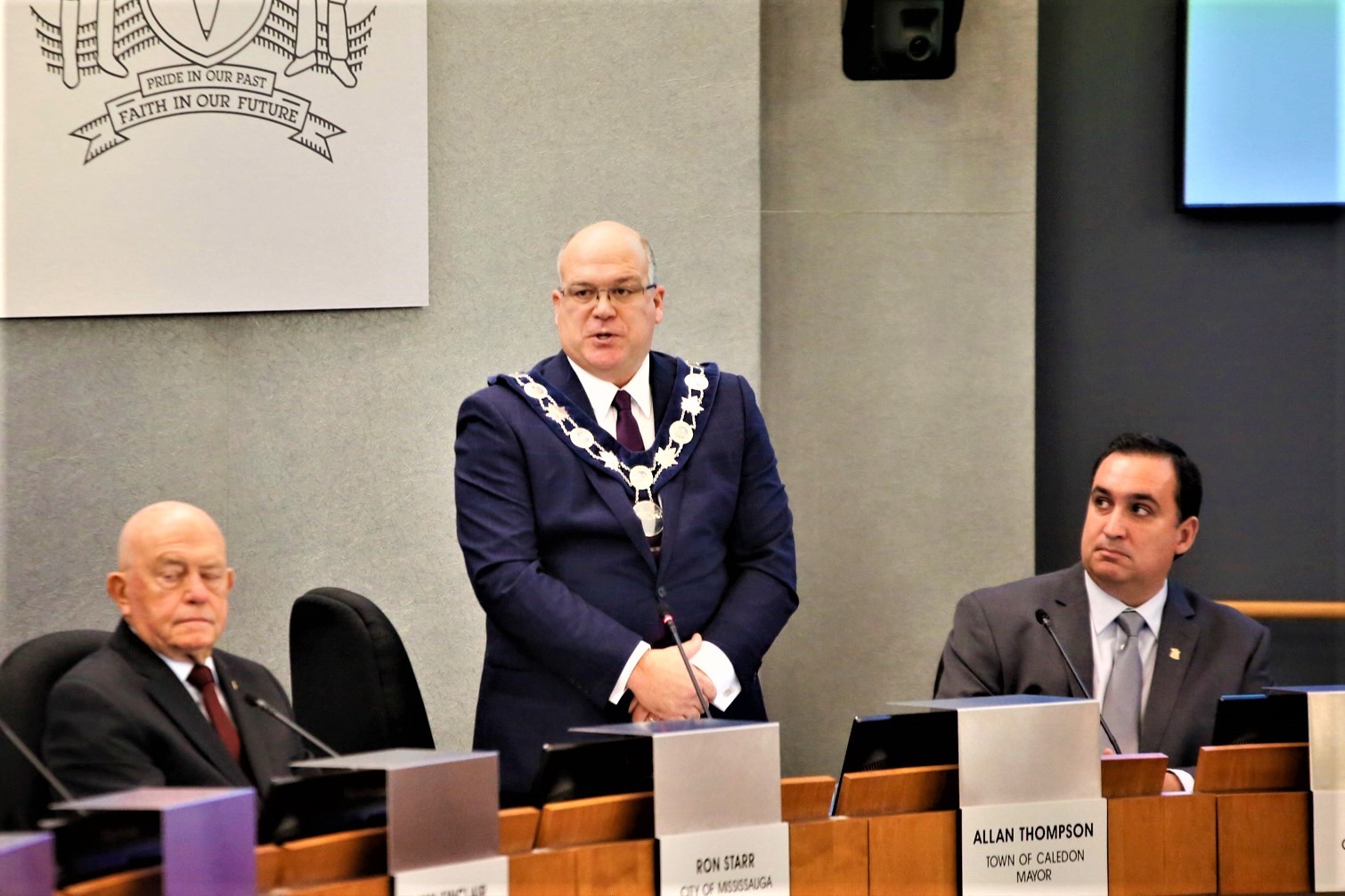
Facing a public backlash, Caledon Mayor Allan Thompson has refused to renounce the GTA West Highway after years of aggressive lobbying for the project.
There are several other examples of Thompson’s historical support for the highway.
The Pointer sent Thompson detailed questions asking him to articulate his position, if he now opposes the GTA West Corridor and to explain how he could support the EA and not the construction of the road that would traditionally follow. The mayor provided only one short response, failing to reply to a follow-up email or address contradictory statements he has made in the past.
“To be clear my support and Caledon’s comments have been centered around the EA,” he wrote. He did not directly address a comment he made in 2018 where he said he had spoken at the Association of Municipalities of Ontario conference “about the importance of the new highway to the future of our community” or a separate comment in which he said, “the GTA West Corridor has already been identified as an necessary piece of growth infrastructure.”
The top item on the Caledon Council 2018-2022 Work Plan states: “Continue to advocate for provincial highway infrastructure including the highway 427 extension and highway 413 (GTA West Corridor).”
When the highway was cancelled in 2018 by the previous Liberal government, Thompson released an official statement on Caledon’s website: “The GTA West Corridor has been identified as a necessary piece of growth infrastructure to help alleviate congestion on Caledon roads and gridlock throughout the GTA… I am disappointed that the Province has discontinued the EA process,” Thompson said.
Then, after Ford reactivated the EA and the project, Thompson released the following statement in late 2018: “The continuation of the EA on the GTA West Corridor has been an advocacy priority for Council for a number of years,” Thompson said. “Just last August, we met with the new Ford Government and the Ministry of Transportation at the last AMO (Association of Municipalities of Ontario) Conference to speak about the importance of the new highway to the future of our community.”
Now, Thompson is somehow trying to separate his support for the current EA from his previous aggressive lobbying to get the 413 Highway built.
“What Caledon residents don’t want to see is our small and picturesque local roads, villages and hamlets used as thru roads for people and goods across the GTHA and I hope the Province looks carefully at that in their planning,” Thompson added in his response to The Pointer. It is unclear what he meant by this statement and he did not respond to a request for clarification.
Thompson’s recent statements have framed the EA as vital to Caledon’s forward planning because it will offer detailed analysis of the whitebelt. This position does not acknowledge that the completion of the EA is the final step before beginning construction of the 400-series highway and that supporting the EA is equivalent to supporting the forward progress of the project.
Muddying the waters is the Province’s stated desire to expedite the EA and get early infrastructure for the highway started. A move Thompson and Innis have pushed.
Their contradictions were singled out by Region of Peel Chair Nando Iannicca on Thursday.
“Well, if you don’t want the highway, why do you want the assessment, I don’t understand,” he said, referring to the willingness of Thompson and his Caledon colleagues, and others, who now say they support an EA, which is the required mechanism to get the highway built. Regional Council, with Thompson, Innis, Downey and Brown’s support, voted to defer a decision on the Mississauga motion until Peel staff bring forward a report on the potential implications.
Innis, despite her role as chair of TRCA, which is opposed to the highway, has not voiced opposition to the project. She was behind a push in October 2019 to ask the Province to speed up its EA process for the highway, a move that would ultimately deliver the highway faster.
“Time is of the essence,” she told provincial officials at a regional council meeting, exhorting them to get the EA for the highway expedited.
It was a confusing position for the chair of the conservation authority. Instead of advocating for a careful, traditional environmental analysis to ensure the protection of watersheds, ecosystems and the overall environment of the region, under her role as the steward of the area’s natural habitats, Innis instead aggressively pushed to skirt these measures in favour of a sped-up process so the early work on the highway infrastructure could begin. Environmental groups and conservation authorities voiced their alarm over the Province's move to expedite a crucial environmental assessement process that could have devastating consequences if cutting corners leads to avoidable, irreversible destruction of the surrounding natural environment.
It was a direct contradiction of her role as chair of the agency mandated to protect against destructive development.
“It has recently been reported in local media that Caledon Council supports and advocates for the GTA West Corridor,” Innis wrote in a recent statement. “To be clear, Caledon Council has only voted to support staff recommendations on the Environmental Assessment and proposed route.”
Council’s official Work Plan disagrees. It highlights council’s support for the construction of the 413 GTA West Highway.
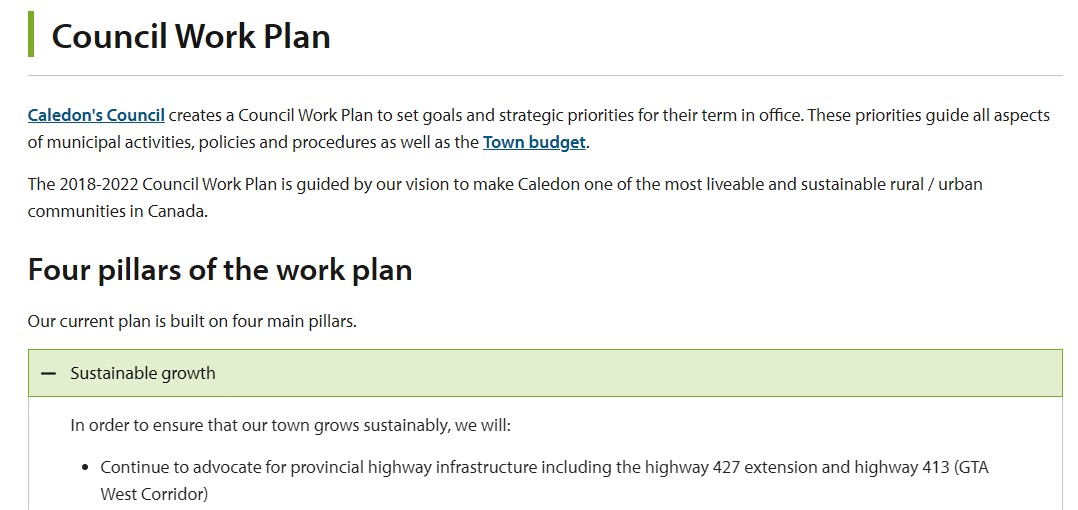
Asked how she and her colleagues could advocate for the highway, but only support the EA process, Innis did not directly answer. Instead she stated she did not wish to see a “mega highway” built through Caledon.
A summer press release from the Province makes it clear the project will feature all the characteristics of a massive highway project. “The GTA West corridor will include a four-to-six lane 400-series highway,” the release states.
“I have always said a future transportation corridor through our community should feature a rail component for either goods so they can safely get to their markets or for people,” Innis said in an email to The Pointer. “What I don’t want to see is 11 million people, which is what the population of the GTHA will be in 25 years, congesting our local roads and costing us millions of dollars to maintain our infrastructure, not to mention the health and safety of our local communities and roadways.”
It is unclear if the EA is considering a rail element; Innis did not respond to follow-up questions. She repeated that completing the EA is important for Caledon’s future planning. Innis addressed concerns that she has a conflict of interest as her family owns large amounts of land in the municipality that would be far more valuable if sold for residential development near the highway. Innis said her family property, located on the edge of Caledon East, would not be sold. She did not provide any other details.
In October, Innis posted on her Facebook page, indicating support for the GTA West Highway, with the inclusion of a rail corridor. “It is our goal to move 50 percent of our population to other modes of transportation (including improving internet to have people work from home) and even with all this, sound planning shows that we still require the GTA West to accommodate our inevitable growth,” she wrote, referencing the Region’s rapidly growing population.
In an earlier Facebook post in 2019, she listed the GTA West Corridor (not its EA) as something she was advocating for.

The Thursday motion from Mississauga, forwarded by Parrish and seconded by Brampton’s Martin Medeiros, threatened to force Caledon’s hand. They avoided taking a position, showing if they still want the GTA West Highway or have now changed their mind. But the motion will be back on the floor in a couple of weeks and they will have to decide which side of the fence they are climbing down on.
“Councils shouldn’t be making rushed and emotional decisions without having detailed information, this is fundamental with evidenced based decision making,” Thompson wrote in a Facebook post explaining his position. “For example, I want to know what the impacts will be in not having some type of corridor in that area. What will that mean to our existing and future communities in 10, 20 and 30 years? What will it mean for our agricultural operators in the area?”
Caledon members who previously pushed for the highway now say they support the federal government completing an EA for the project (and taking it away from Queen’s Park) but do not have a position on the highway itself.
It’s a move sparked by Environmental Defence and Ecojustice who recently called on Ottawa to intervene.
“Caledon's support for a federal Environmental Assessment, at the request of local residents, is welcome,” Sarah Buchanan, Ontario climate program manager for Environmental Defence, told The Pointer. “Residents have been asking for the Mayor and Councillors to carefully review the facts at hand, including the long-term impacts of this highway on local economies and ecosystems, before making a final decision. It's clear that the concerns of Caledon residents are surfacing, but will these concerns be fully heard? That remains to be seen.”
Email: [email protected]
Twitter: @isaaccallan
Tel: 647 561-4879
COVID-19 is impacting all Canadians. At a time when vital public information is needed by everyone, The Pointer has taken down our paywall on all stories relating to the pandemic and those of public interest to ensure every resident of Brampton and Mississauga has access to the facts. For those who are able, we encourage you to consider a subscription. This will help us report on important public interest issues the community needs to know about now more than ever. You can register for a 30-day free trial HERE. Thereafter, The Pointer will charge $10 a month and you can cancel any time right on the website. Thank you.
Submit a correction about this story


